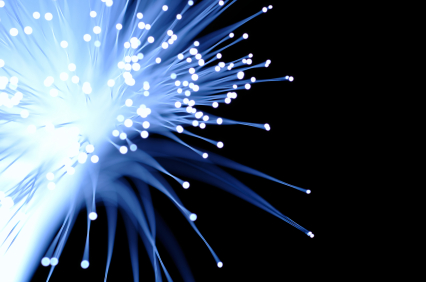 You’ve probably been hearing a lot about fiber Internet lately. It’s generating a lot of buzz in the tech industry, and that buzz is changing the way we live our lives online. But what is fiber exactly, and how will it affect the way you use the Internet?
You’ve probably been hearing a lot about fiber Internet lately. It’s generating a lot of buzz in the tech industry, and that buzz is changing the way we live our lives online. But what is fiber exactly, and how will it affect the way you use the Internet?
Fiber-optic Internet—in a nutshell—is super-fast Internet that operates on fiber-optic cables rather than copper phone lines (like DSL) or cable connections. Just as dial-up Internet connections were phased out as technology advanced, many people are now switching from DSL or cable Internet to faster, even more efficient fiber Internet.
Full Speed Ahead
A fiber-optic connection can send a larger volume of information over longer distances faster than ever before, making it possible for you to surf the web, stream videos, play games, and upload files at lightning speed. A 1000 Mbps connection—sometimes known as 1 Gig or gigabit Internet—will provide speeds up to 20 times faster than most high-speed services (based on max download speed of AT&T Internet 1000). With speeds that fast, you could download 25 songs in one second, a 30-minute TV show in under four seconds, or a 90-minute HD movie in under 34 seconds.
As our world becomes more connected and as each person in your home is using more technology that requires Internet access, you’ll need more bandwidth to comfortably use all your devices at the same time. Think about everything that’s connected in your home right now: TV’s, laptops, smartphones, tablets, printers, home security systems, game consoles, etc. They’re all necessary devices and they all soak up your bandwidth at an incredible rate, resulting in slower frame rates and longer buffering times. That’s why AT&T offers fiber Internet plans with enough bandwidth to keep your life running smoothly.
Get 100 Mbps speed with Internet 100 or connect up to 50 devices with ultra-fast 1000 Mbps speed on Internet 1000.
Safe, Reliable Connectivity
In addition to revolutionary speeds, a fiber connection is far more dependable and safe than other Internet connections. You’re less likely to lose service during a power outage with fiber-optic Internet because your connection isn’t dependent on electricity. And, fiber Internet is a private network installed in your home, so it’s much harder to hack into, providing better protection from online threats (Chianis, 2016).
Keep Moving Forward
AT&T Fiber opens up a host of exciting possibilities for both individuals and communities. Fiber-fast speeds can streamline and simplify a technology-driven lifestyle, making better use of your time while attracting new business opportunities that can boost local economies, and enriching education and research programs. Take advantage of the best technology available with AT&T Fiber.
How to Get Fiber Internet Service
AT&T has the largest* fiber network in the U.S.—available in over 40 metropolitan areas across California, the Midwest, and the South—and is currently expanding into many more locations. Find out if AT&T Fiber is available in your city. Check out all AT&T Internet plans here.
*Based on publicly available data for the top fiber providers in the AT&T operating footprint.
References
Alexia Chianis. “DSL vs. Fiber-Optic: Which Internet Service Is Better for Small Businesses?”BusinessBee. N.p., 18 Nov. 2016. Web. 06 Mar. 2017.
